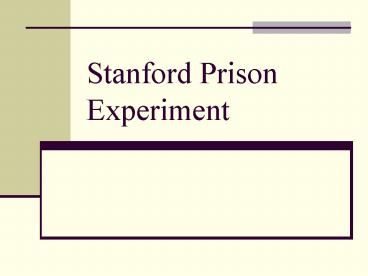Stanford Prison Experiment PowerPoint PPT Presentation
1 / 21
Title: Stanford Prison Experiment
1
Stanford Prison Experiment
2
Background
- Landmark psychological study of the human
response to captivity. - Conducted in 1971
- Led by Philip Zimbardo of Stanford University.
- Volunteers played the roles of the guards and
prisoners.
3
- Funded by the U.S Navy to explain conflicts in
its and the Marine Corps prison systems
4
Hypothesis
- Prison guards and convicts were self selecting
that would naturally lead to poor conditions in
that situation.
5
Participants
- Recruited via a newspaper ad
- Offered 15 a day
- Participate in a mock prison simulation for 2
weeks - 24 were chosen based on a series of tests that
proved they were the most psychologically stable
and healthy. - White, middle class, young males.
6
Roles
- Divided in half into equal groups of prisoners
and guards. - Coin toss
7
Prison
- Mock jail
- Basement of Stanford Psych. Dept
- Research Assistant was the Warden
- Zimbardo was the Superintendent
8
Goals
- Depersonalization
- Deindividualization
- Disorientation
9
Guards
- Wooden Batons, military style uniforms and
mirrored sunglasses. - Work in shifts and return home during off hours.
- Given no formal guidelines except that they were
not allowed to touch the prisoners.
10
(No Transcript)
11
Prisoners
- ill fitting smocks (no underwear)
- Sandals
- Assigned s no names
- Nylon pantyhose caps
- Small chain around ankles
12
(No Transcript)
13
The Beginning
- Participants were charged with armed robbery by
real police officers. - Fingerprinting, mug shots, strip searched and
deloused.
14
Results
- Prisoners suffered sadistic and humiliating
treatment. - Developed severe emotional disturbances (crying
and disorganized thinking). - Riots
- Strenuous punishments were imposed. (i.e.
push-ups) - Prison became unsanitary and bathroom rights
became privileges.
15
(No Transcript)
16
Results (cont)
- Clean toilets with bare hands.
- Sleep on concrete floor naked.
- Denied food.
- Guards became more and more sadistic.
17
(No Transcript)
18
The End
- After only 6 days the experiment was shut down!!
19
Conclusions
- Argued to demonstrate obedience of people and
power of authority. - Situation caused the behavior not inherent
personalities. - Compared to Miligram experiment.
20
Criticisms
- Unethical
- Results cannot be reproduced or replicated
- Zimbardo was not a neutral observer
- Not like an actual prison
- Sample size was too small
- People who were drawn to the ad in the newspaper,
may be predisposition for violent behavior.
21
Questions
- Was it right to trade suffering experienced by
the participants for the knowledge gained by the
research? Why or why not? - If you were an experimenter in charge, would you
have done this study? How could you have made
the study more ethical?

